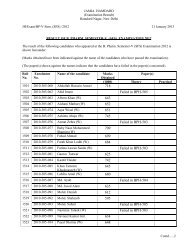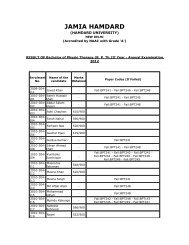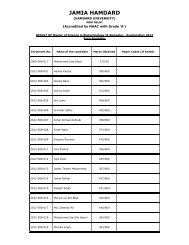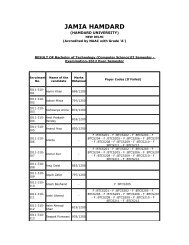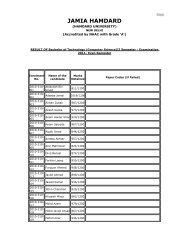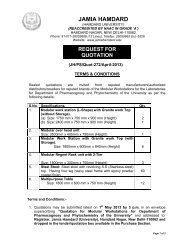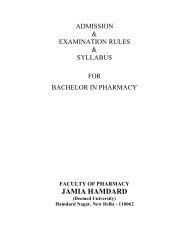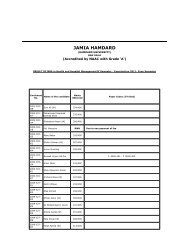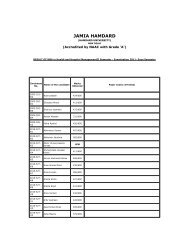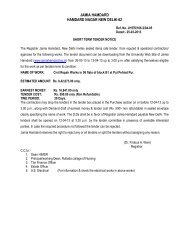J.H HERBAL GARDEN At-A-GLANCE - Jamia Hamdard
J.H HERBAL GARDEN At-A-GLANCE - Jamia Hamdard
J.H HERBAL GARDEN At-A-GLANCE - Jamia Hamdard
Create successful ePaper yourself
Turn your PDF publications into a flip-book with our unique Google optimized e-Paper software.
J.H<br />
<strong>HERBAL</strong> <strong>GARDEN</strong><br />
<strong>At</strong>-A-<strong>GLANCE</strong><br />
Department of Botany, Faculty of Science<br />
<strong>Jamia</strong> <strong>Hamdard</strong>, <strong>Hamdard</strong> Nagar, New Delhi-110062<br />
Website: www.jamiahamdard.edu/www.jamiahamdard.ac.in
J.H.<br />
<strong>HERBAL</strong> <strong>GARDEN</strong><br />
<strong>At</strong>-A-<strong>GLANCE</strong><br />
1989-2011<br />
Department of Botany, Faculty of Science<br />
<strong>Jamia</strong> <strong>Hamdard</strong>, <strong>Hamdard</strong> Nagar,<br />
New Delhi-110062<br />
Website:<br />
www.jamiahamdard.edu/www.jamiahamdard.ac.in
FOUNDER OF THE UNIVERSITY<br />
Institute of History of Medicine and Medical Research was founded by Late Hakeem<br />
Abdul Hameed Sahib, a world renowned practitioner of Unani Medicine in 1962 under<br />
<strong>Hamdard</strong> National Foundation and was given the status of deemed university by the<br />
University Grants Commission in 1989.
MISSION<br />
The Herbal Garden of <strong>Jamia</strong> <strong>Hamdard</strong> strives on economic activity relating to cultivation,<br />
propagation and conservation of herbal plants including rare, endangered, threatened and<br />
endemic plants from different agro-climatic zones of India for sustainable supply of raw<br />
material to the herbal and aromatic departments/industries for viable research /enterprise.<br />
OBJECTIVES<br />
• To introduce the plants from different geographical zones for having medicinal<br />
importance at commercial level.<br />
• To design the agro-techniques for cultivation and propagation of medicinal plants<br />
and standardize them.<br />
• Document and inventorise all the medicinal plants growing in herbal garden on the<br />
basis of their passport data.<br />
• Raising the biomass (ex-situ conservation) for research and teaching departments<br />
and for exchange programmes.<br />
• To study and assess various environmental stresses on the medicinal plants<br />
affecting their secondary metabolites.<br />
• To establish Germplasm bank , seed bank /gene bank for all the accessions collected<br />
and transplanted from various agro-climatic zones.
PROGRAMMES AND ACTIVITIES<br />
1. Introduction of medicinal and aromatic plants from north-west regions of India<br />
for their diversity assessment.<br />
2. Developing cultivation methods of medicinal and aromatic plants for their<br />
demonstration.<br />
3. Conservation strategies of rare, endangered and threatened species of Delhi and<br />
its surrounding states.<br />
4. Conducting agro-techniques of medicinal and aromatic plants.<br />
5. Transplantation of Germplasm at larger scale.<br />
6. Establishment of Germplasm and seed banks of potentially important medicinal<br />
and aromatic plants.<br />
7. Production of seeds of tropical and temperate medicinal plants.<br />
8. Data compilation and accession of seeds of potentially important medicinal and<br />
aromatic plants.<br />
9. To serve as repository for future research and teaching.<br />
UNITS OF <strong>HERBAL</strong> <strong>GARDEN</strong><br />
Herbal garden has the following units:<br />
• Plant introduction unit<br />
• Potted plant unit<br />
• Experimental unit<br />
• Climbers unit<br />
• Germplasm repositories<br />
• Propagation sites<br />
• Medicinal arboretum<br />
• Phytotrons (controlled growth chamber)
FROM THE VICE-CHANCELLOR’S DESK<br />
It is hearting to note that the Department of Botany , <strong>Jamia</strong> <strong>Hamdard</strong> is<br />
bringing out the first Brochure on Herbal Garden<br />
<strong>Jamia</strong> <strong>Hamdard</strong> has privilege to set up a herbal garden within the campus<br />
which spreads on six acres of land where about 150 species of important<br />
traditional medicinal and aromatic plants, herbs, shrubs and trees are<br />
flourishing. The main purpose of the garden is to facilitate the experimental<br />
work and initiate the ex-situ conservation of rare medicinal plants. Our<br />
faculty of Science has centre for Transgenic Plant development within the<br />
department of Bio-technology with state of the art facilities, the Botanical<br />
garden is also catering to the needs of this facility.<br />
The establishment of herbal garden was also one of the ambitions and desire<br />
of the founder of <strong>Jamia</strong> <strong>Hamdard</strong> , late Hakeem Abdul Hameed.<br />
Growth and evolution are the hallmark of a vibrant organization. From this<br />
perspective the strides made by the department of botany towards setting up<br />
and maintaining a Botanical garden are impressive. Considerable efforts are<br />
being made to conduct research on herbs to harvest their potential for drug<br />
designing as well as drug delivery.<br />
I am sure that the Botanical garden in the <strong>Jamia</strong> <strong>Hamdard</strong> campus will play a<br />
very important role in educating people and serve as a training centre for the<br />
students and the herbal practitioners. I appreciate the efforts which have been<br />
put in bringing out this information.<br />
(Dr. G.N.QAZI)
FROM THE HEAD, DEPARTMENT OF BOTANY’S DESK<br />
Conservation of plant assumes a greater importance in the world because its diversity gets lost<br />
unprecedently which compels the scientific community to conserve and preserve t he plant species now on<br />
the IUCN red data list for their conservation on priority.<br />
<strong>Jamia</strong> <strong>Hamdard</strong> established in 1989, is situated on Mehrauli-Badarpur road, whose founder was<br />
the world renowned Unani Physician, Late Hakeem Abdul Hamid and it has 97 acres of land. the campus<br />
has seven faculties, a beautiful central library, convention complex, modern sports facilities, scholar’s<br />
house and residential quarters.<br />
Out of the total land area, 6 acres have been earmarked for herbal garden, where trees shrubs,<br />
climbers and herbs are grown and cultivated. T he main aim of the herbal garden is to cater the needs of<br />
teaching and research departments, faculties of Science and Unani medicine. Herbal garden has raised<br />
huge repository of commercially important medicinal and aromatic plants growing in Delhi and its<br />
adjoining states and areas, being used in Indian systems of medicine and also in designing the herbal<br />
drugs.<br />
Herbal garden is being maintained for its specific objectives like conservation and propagation of<br />
rare, and endemic medicinal and aromatic plants and to make inventories and document them on their<br />
passport data.<br />
The herbal garden has well irrigation systems for scientifically designed beds for cultivation and<br />
propagation of plant materials procured from different agro climatic zones. Specific portion of land has<br />
been used for arboreal plants.<br />
The present document serves preliminary information on medicinal and aromatic plants used for<br />
herbal drugs. The herbal garden also serves a road map for the people to get training for establishing<br />
herbal gardens in their places of residence as home gardens. In near future, the university is planning to<br />
organise regular training courses for the people associated with cultivation and making the rare herb for<br />
indigenous Health Care Systems. The general lack of information and limited knowledge of Herbal<br />
diversity of the common people will increase through the present publication.<br />
I congratulate the consultants for their efforts and convey my best wishes for this publication. I<br />
appreciate the efforts of the Dean and my predecessor and wish grand success on this outdoor academic<br />
activity.<br />
(Prof. Javed Ahmad)
<strong>HERBAL</strong> <strong>GARDEN</strong><br />
Establishment of Herbal garden is a part of the house hold landscape throughout the world<br />
since time immemorial and all such gardens are often valued for their essence and beauty.<br />
The main aim of the herbal garden is to preserve and promote the medicinal values of the<br />
plants which grow mostly wild, in our surrounding and whose properties are beneficial in<br />
maintaining a balance between man and nature. The herbal garden generally consists of all<br />
the herbs which have medicinal and aromatic properties. Herbal gardens are the precious<br />
source of raw material for medicinal remedies used in primary health care. Presently<br />
medicinal and aromatic plants are becoming increasingly economically important due to<br />
growing demand for herbal products in the domestic and global market and over 90% of<br />
the medicinal plants used by pharmaceutical industry are harvested from the wild in an unsustainable<br />
manner. As a result of destructive harvesting of medicinal plants and loss and<br />
fragmentation of natural habitats majority of the species now in red list of the international<br />
union of conservation of nature (IUCN) Both the folk medicinal culture and the codified<br />
classical health system of medicine is eroding due to economic, cultural and political<br />
pressure not because they are in-effective. Number of advantages are gained from the<br />
establishment of herbal garden as is ready fresh natural resource available for ingredients<br />
medicinally.<br />
Keeping in view the importance of herbal garden <strong>Jamia</strong> <strong>Hamdard</strong> has established an<br />
Herbal Garden spread over 6 acres of land where more than 200 rare, threatened and<br />
commercially important medicinal plants have been introduced from various regions of<br />
Northern India for cultivation and propagation. The main aim of the garden is to conserve<br />
all the accessions of Plant Germplasm for repository and Germplasm Banks. Herbal<br />
Garden at <strong>Jamia</strong> <strong>Hamdard</strong> serves an important tool for teaching and research in other<br />
related faculty of science and pharmacy.<br />
1. Ph- 7.88<br />
2. Organic carbon - 0.17%<br />
3. Phosphorus (P)- 3.7 kg/ha<br />
4. Potassium (K)- 113 kg/ha<br />
5. Nitrogen (N)- 230kg/ha<br />
6. Sulphur (S)-17.33 kg/ha<br />
7. Zinc (Zn)- 1.31 mg/kg<br />
pH of running water – 8.02<br />
SOIL ANALYSIS OF <strong>HERBAL</strong> <strong>GARDEN</strong>,<br />
JAMIA HAMDARD
List of some commonly used plants in the Indian Systems of Medicine growing in the<br />
herbal garden, <strong>Jamia</strong> <strong>Hamdard</strong>.<br />
Angiosperms<br />
Annual& Perennial Herbs<br />
S.No Botanical name Family English name Common<br />
/Unani/Ayurvedi<br />
c names<br />
1 Abroma augusta (L.) L.f. Sterculiaceae Devil’s cotton Ulatkambal<br />
2 Achillea millefolium L. Asteraceae Milfoil , Yarrow Biranjasif<br />
3 Acorus calamus L. Araceae Sweet flag Bach/Vaj<br />
4 Ageratum conyzoides L. Asteraceae Goat weed Uchanti<br />
5 Aloe vera (L.) Burm.f. Liliaceae Barbados aloe Gheekanwar/Elva<br />
6 Alpinia calcarata Rosc. Zingiberaceae Snap ginger<br />
7 Alpinia galanga (L.) Willd. Zingiberaceae The greater<br />
galangal<br />
Khulanjan<br />
8 Althea officinalis L. Malvaceae Marsh Mallow Khatmi /Gulkhairo<br />
9 Ammi majus L. Apiaceae Crow’s feet <strong>At</strong>rilal<br />
10 Anacyclus pyrethrum (L.) Lag. Asteraceae Spanish pellitory Akarkara<br />
11 Andrographis paniculata<br />
(Burm.f.) Nees.<br />
Acanthaceae Creat , King of<br />
bitters<br />
12 Apium graveolens L. Apiaceae Celery Ajmod<br />
13 Asclepias tuberosa L. Asclepiadaceae Milkweed<br />
14 Bacopa monnieri (L.) Penn. Scrophulariacea<br />
e<br />
Thyme Leaved<br />
Gratiola<br />
15 Boerhaavia diffusa L. Nyctaginaceae Spreading Hogweed<br />
Kalmegh/ Kiryat<br />
Brahmi<br />
Punarnava<br />
16 Bryophyllum pinnatum(Lam.) Crassulaceae Air plant Zakhme –hayat
Oken<br />
17 Cannabis sativa L. Cannabinaceae True hemp Bhang<br />
18 Carthamus tinctorius L. Asteraceae Safflower Kusum<br />
19 Cheilocostus speciosus<br />
(Koenig.) C. Specht (syn:<br />
Costus speciosus (Koenig)<br />
Sm.)<br />
Zingiberaceae Crap ginger -----<br />
20 Cichorium intybus L. Asteraceae Chicory Kasni<br />
21 Curcuma longa L. (syn:<br />
Curcuma domestica Valeton)<br />
Zingiberaceae Turmeric Haldi<br />
22 Cymbopogon citratus Stapf. Poaceae Lemon grass Izkhir<br />
23 Datura in noxia Mill. Solanaceae Thorn apple Dhatura<br />
24 Datura metel L. Solanaceae Thorn apple Dhatura<br />
25 Datura stramonium L. Solanaceae Mad apple Dhatura<br />
26 Echinacea purpurea (L.)<br />
Moench.<br />
Asteraceae Cone flower ---<br />
27 Elettaria cardamomum Maton Zingiberaceae Cardamom Chhoti-elaichi<br />
28 Eltingera elatior (Jack) R.M.<br />
Sm. (syn: Alpinia speciosa<br />
K.Schum.)<br />
Zingiberaceae The light galangal ----<br />
29 Foeniculum vulgare Mill. Apiaceae Sweet fennel Saunf<br />
30 Glycyrrhiza glabra L. Fabaceae Liquorice Mulethi<br />
31 Hedychium spicatum Buch. -<br />
Ham<br />
Zingiberaceae Spiked Ginger<br />
Lily<br />
32 Heracleum candicans Wall. Apiaceae - -<br />
33 Inula racemosa Hook.f. Asteraceae - Kuth<br />
Kapurkachri<br />
34 Lepidium sativum L. Brassicaceae Garden cress Halim/Haloon<br />
35 Linum usitatissimum L. Linaceae Linseed Alsi
36 Majorana hortensis Moench Lamiaceae Sweet marjoram Murwa<br />
37 Malva sylvestris L. Malvaceae Malva Khubazi<br />
38 Matricaria chamomilla L. Asteraceae Chamomile Babuna<br />
39 Mentha aquatica L. Lamiaceae Water mint, Marsh<br />
mint<br />
Podina-nehri<br />
40 Mentha arvensis L. Lamiaceae Japanese mint Pudina-filfemun<br />
41 Mentha longifolia (L.) Huds. Lamiaceae Carvone rich –<br />
mint, Horse mint<br />
42 Mentha piperita L. emend.<br />
Huds<br />
Podina-barri<br />
Lamiaceae Peppermint Podina-filfili<br />
43 Mentha spicata L. Lamiaceae Garden mint Pahari pudina<br />
44 Mirabilis jalapa L. Nyctaginaceae Marvel of peru Gul-abbas<br />
45 Musa paradisiaca L. Musaceae Edible banana Kela<br />
46 Nepeta cataria L. Lamiaceae Catnip ----<br />
47 Nigella sativa L. Ranunculaceae Black cumin Kalaunji<br />
48 Pittosporum napaulense (DC.)<br />
Rehder & Wilson<br />
Pittosporaceae - -<br />
49 Plantago major L. Plantaginaceae Spogel seeds Bartang<br />
50 Plantago ovata Forsk. Plantaginaceae Blond psyllium Isabghol<br />
51 Plectranthus amboinicus<br />
(Lour.) Spreng. (syn: Coleus<br />
aromaticus Benth.)<br />
52 Plectranthus barbatus<br />
Andrews. (syn: Coleus<br />
forskohlii (Poir.) Briq. )<br />
53 Pluchea lanceolata C. B.<br />
Clarke<br />
Lamiaceae French thyme,<br />
Mexican mint<br />
----<br />
Lamiaceae Kaffir potato Patharchur<br />
Asteraceae --- Rasna<br />
54 Polianthes tuberosa L. Amaryllidaceae Tuberose Gulshabbo/
Rajnigandha<br />
55 Rosmarinus officinals L. Lamiaceae Rosemary Rusmari<br />
56 Salvia aegyptiaca L. Lamiaceae Egyptian sage Tukham malanga<br />
57 Silybum marianum Gaertn. Asteraceae Milk-Thistle ----<br />
58 Simarouba glauca DC. Simaroubaceae Paradise tree Laxmitaru<br />
59 Solanum nigrum L. Solanaceae Black nightshade Makoi<br />
60 Solanum virginianum L. (syn:<br />
Solanum xanthocarpum<br />
Schrad & Wendl.)<br />
61 Sphagneticola trilobata (L.)<br />
Pruski (syn: Wedelia trilobata<br />
L.)<br />
Solanaceae Yellow -Berried<br />
Nightshade<br />
Asteraceae Singapore daisy<br />
Kateli<br />
62 Tagetes minuta L. Asteraceae Stinking -Roger Chhota Genda<br />
63 Taraxacum officinale Weber<br />
ex Wiggers<br />
64 Trachyspermum ammi (L.)<br />
Sprague.<br />
Asteraceae Common<br />
Dandelion<br />
Apiaceae Carum Ajwain<br />
Kanphul/Dulal<br />
65 Trigonella foenum-graecum L. Fabaceae Fenugreek Hulba/ Methi<br />
66 Urginia indica Kunth Liliaceae Indian squill Jangli piyaz<br />
67 Viola serpens Wall ex Ging. Violaceae Sweet violet Banafshah<br />
68 Valeriana wallichii DC. Valerianaceae Indian valerian Mushkbala<br />
69 Withania somnifera Dunal Solanaceae Winter cherry Asgand/<br />
Ashwagandha<br />
70 Zephyranthes grandiflora<br />
Lindl.<br />
Amaryllidaceae Zephyr -Flower
Climbers<br />
71 Abrus precatorius L. Fabaceae Indian<br />
Liquorice<br />
72 Adenocalymma nitidum<br />
Mart.ex DC.<br />
Ghunghchi/ Ratti<br />
Bignoniaceae ---- Lahsun Bel<br />
73 Asparagus adscendens Roxb. Liliaceae Musale Safed musli<br />
74 Asparagus racemosus Willd. Liliaceae Wild<br />
Asparagus<br />
75 Cisssus quadrangularis L. Vitaceae Edible-<br />
Stemmed<br />
Vine<br />
Satawar<br />
Hadjora<br />
76 Clitoria ternatea Linn. Fabaceae Butterfly pea Aprajita/<br />
Shankhpushpi<br />
77 Dioscorea bulbifera L. Dioscoreaceae Potato yam Ratalu<br />
78 Ichnocarpus frutescens R.Br. Apocynaceae Black creeper Kalidudhi<br />
79 Gloriosa superba L. Liliaceae Malabar<br />
Glory lily<br />
80 Gymnema sylvestre R.Br. Asclepiadaceae Miracle fruit Gurmar<br />
81 Jasminum humile L. Oleaceae Yellow<br />
jasmine<br />
82 Mucuna prurita Hook. Fabaceae Common<br />
Cowitch<br />
Kalihari/ Karihari<br />
Peeli chameli<br />
Kaunch<br />
83 Rourea minor (Gaertn.) Alston Connaraceae --- Vidhara<br />
84 Tinospora cordifolia (Willd.)<br />
Miers.<br />
85 Tylophora indica (Burm.f.)<br />
Merrill.<br />
Menispermaceae Gulancha Giloe<br />
Asclepiadaceae Emetic<br />
Swallow-wort<br />
Antamul
Shrubs<br />
86 Annona squamosa Linn. Annonaceae Custurd apple Sharifa<br />
87 Artemisia absinthium Linn. Asteraceae Absinthe,<br />
Wormwood<br />
Vilayati<br />
afsanthin<br />
88 Barleria prionitis L. Acanthaceae Crossandra Vajradanti<br />
89 Berberis asiatica Roxb. ex DC Berberidaceae Indian barberry Kilmora<br />
90 Bixa orellana Linn. Bixaceae Annatto Tree Sinduri /Latkan<br />
91 Caesalpinia crysta Linn Caesalpiniaceae Fever nut Karanjwa<br />
92 Calotropis gigantea (L.) R.Br. Asclepiadaceae Crown flower Aak<br />
93 Camellia japonica L. Theaceae Garden<br />
Camellia<br />
94 Catharanthus roseus G.Don. Apocynaceae Peri winkle Sadabahar<br />
95 Celastrus paniculatus willd. Celastraceae Celastrus Malkangni<br />
96 Cestrum diurnum L. Solanaceae Day jasmine Din ka raja<br />
97 Cestrum nocturnum L. Solanaceae Night jasmine Rat ki rani<br />
98 Cestrum elegans (Brongn.)<br />
Schltdl.<br />
Solanaceae Purple cestrum<br />
99 Clerodendrum phlomidis L.f. Verbenacae Arni<br />
100 Commiphora wightii (Arn.)<br />
Bhandari<br />
Burseraceae Indian<br />
Bdellium Tree<br />
-<br />
Guggal<br />
101 Euphorbia tirucalli L. Euphorbiaceae Milk Bush Sehund<br />
102 Grewia asiatica Mast. Tiliaceae Indian phalsa Falsa<br />
103 Holarrhena antidysenterica<br />
(L.) Wall.<br />
Apocynaceae Kurchi bark Kurchi/ Inder Jo-<br />
Talkh<br />
104 Ipomoea hederacea Jacq. Convolvulaceae Ivy- leaved Kala dana / Hab-
105 Jasminum sambac (L.) Ait. Oleaceae Arabian<br />
jasmine<br />
morning glory ul-nil<br />
Moghra / Motia<br />
106 Jatropha curcas L. Euphorbiaceae Physicnut Jangli arand<br />
107 Jatropha gossypifolia L. Euphorbiaceae Bellyachebush,<br />
Black<br />
Physicnut<br />
108 Jatropha integerrima Jacq. Euphorbiaceae Fiddle-head<br />
jatropha<br />
109 Justicia adhatoda L. (syn:<br />
Adhatoda zeylanica Nees)<br />
Acanthaceae Vasaca Arusa/ Bansa<br />
110 Lawsonia inermis L. Lythraceae Henna Heena / Mehndi<br />
111 Nerium oleander L. (syn:<br />
Nerium indicum Mill.)<br />
Apocynaceae Indian<br />
Oleander<br />
Kaner<br />
112 Nyctanthes arbor-tristis L. Oleaceae Coral jasmine Harsinghar<br />
113 Pandanus fascicularis Lam. Pandanaceae Screw-pine Keora<br />
114 Pelargonium graveolens<br />
L’Herit<br />
Geraniaceae Scented<br />
geranium<br />
Geranium<br />
115 Plumbago zeylanica L. Plumbaginaceae Leadwort Chitrak<br />
116 Psoralea corylifolia L. Fabaceae Scurfy pea Babchi<br />
117 Rauvolfia serpentina Benth.ex<br />
Kurz<br />
Apocynaceae Serpent root Asrol-<br />
Sarpagandha/buti<br />
118 Rauvolfia tetraphylla L. Apocynaceae Wild snake<br />
root<br />
Barachandrika<br />
119 Rosa damascena Mill. Rosaceae Damask rose Fasli gulab<br />
120 Ruta graveolens L. Rutaceae Garden Rue Sudab<br />
121 Sambucus canadensis L. Caprifoliaceae American<br />
Elder
122 Sarcostemma acidum voigt Asclepiadaceae --- Somlata, Soma<br />
123 Stevia rebaudiana Bertoni Asteraceae Sweet leaf<br />
124 Tamarix aphylla (L.)karst. Tamaricaceae Tamarisk Lal-Jhau<br />
125 Tecoma stans (L.) H.B & K. Bignoniaceae Yellow bells Piliya<br />
126 Viburnum co tinifolium D.Don Caprifoliaceae ---- ----<br />
127 Vitex negundo L. Verbenaceae Five leaved<br />
chaste tree<br />
128 Wrightia tinctoria R.Br Apocynaceae Pala Indigo<br />
plant<br />
Nirgundi,<br />
Sambhalu<br />
Inderjao shirin<br />
129 Zanthoxylum alatum Roxb. Rutaceae Toothache tree Kababi-khandan<br />
/Timur<br />
Trees<br />
130 Adansonia digitata L. Bombacaceae Baobab Kalp vriksha / Gorakh<br />
imli<br />
131 Aegle marmelos<br />
Correa ex Roxb.<br />
132 Azadirachta indica<br />
A.Juss.<br />
Rutaceae Wood apple Bel<br />
Meliaceae Margosa Tree Neem<br />
133 Bombax ceiba L. Bombacaceae Silk cotton tree Semul<br />
134 Chukrasia tabula ris<br />
A. Juss.<br />
135 Cinnamomum tamala<br />
(Buch) Buch H- Ham<br />
Nees & Eberm.<br />
136 Cinnamomum<br />
camphora (L.) J. Presl<br />
137 Citrus maxima<br />
(Burm.) Merrill.<br />
Meliaceae Chittagong<br />
Wood<br />
Lauraceae Indian Cassia<br />
Lignea<br />
Chickrassy<br />
Tezpatta<br />
Lauraceae Camphor Kapur / Kafur<br />
Rutaceae Forbidden fruit Chakotra<br />
138 Citrus medica L. Rutaceae Citron Bara nibu
139 Citrus sinensis L. Rutaceae Sweet orange Narangi<br />
140 Dalbergia sissoo<br />
Roxb.<br />
141 Elaeocarpus ganitrus<br />
Roxb.<br />
142 Emblica officinalis<br />
Gaertn.<br />
143 Manilkara hexandra<br />
(Roxb.) Dubard<br />
Fabaceae Sissoo Sheesham<br />
Elaeoocarpaceae Utrasum Bead<br />
Tree<br />
Euphorbiaceae Indian<br />
Gooseberry<br />
Sapotaceae Ceylone iron<br />
wood/ Milk tree<br />
Rudraksha, hudraki<br />
Amla /Amlaj<br />
Khirni<br />
144 Mesua ferrea L. Clusiaceae Trade -Mesua Nagkesar<br />
145 Moringa oleifera Lam. Moringaceae Drumstick Tree Sajna, Soajna<br />
146 Murraya koenigii<br />
(L.)Spreng.<br />
147 Oroxylum indicum<br />
Vent.<br />
148 Pithecellobium dulce<br />
Benth.<br />
149 Pongamia pinnata<br />
Pierre<br />
150 Prunus cerasoides<br />
D.Don<br />
151 Quercus glauca<br />
Thumb.<br />
Rutaceae Curry leaf tree Kurry patta<br />
Bignoniaceae Broken bones<br />
plant/ Indian<br />
trumpet tree<br />
Mimosaceae Manila<br />
Tamarind<br />
Fabaceae Indian Beech,<br />
pangam oil tree<br />
Rosaceae Himalyan Wild<br />
Cherry<br />
Fagaceae Blue Japanes<br />
Oak<br />
152 Psidium guajava L. Myrtaceae Common<br />
Guava<br />
Arlu, Ullu<br />
Jangal jalebi, Vilayati<br />
imli<br />
Karanj<br />
Padam<br />
-<br />
Amrud<br />
153 Punica granatum L. Punicaceae Pomegranate Dadima/Anar<br />
154 Santalum album L. Santalaceae Sandal Tree Safeed/Chandan/Sandal
155 Sapindus mukorossi<br />
Gaertn.<br />
156 Saraca asoka (Roxb.)<br />
De Wilde<br />
157 Senna alexandrina<br />
Mill. (syn: Cassia<br />
angustifolia Vahl.)<br />
158 Spondias pinnata<br />
(L.f.) Kurz<br />
159 Syzygium cuminii<br />
(L.) Skeels<br />
Sapindaceae Soapnut tree Reetha<br />
Caesalpiniaceae Ashoka Asok<br />
Caesalpiniaceae Indian senna Sena<br />
Anacardiaceae Wild Mango Amara/ Jangliam<br />
Myrtaceae Black P lum Jaman<br />
160 Tamarindus indica L. Caesalpiniaceae Tamarind Tree Imli<br />
161 Terminalia arjuna<br />
(Roxb.) Wight & Arn.<br />
162 Terminalia bellirica<br />
Roxb.<br />
Combretaceae Trade -Arjun Arjuna<br />
Combretaceae Bellaric<br />
Myrobalan<br />
163 T. chebula Retz Combretaceae Chebulic<br />
Myrobalan<br />
164 Vitex agnus-castus<br />
Linn.<br />
Gymnosperms<br />
Bahera<br />
Har<br />
Verbenaceae Chaste-Tree ---<br />
165 Agathis sps. Araucariaceae --<br />
166 Cedrus deodara (Roxb.)<br />
Loud.<br />
167 Cryptomeria japonica (L.f.)<br />
D.Don<br />
Pinaceae Himalayan C edar Deodar<br />
Pinaceae Japanese C edar Dhupi<br />
168 Cycas circinalis L. Cycadaceae --- Jangli- madan<br />
mast ka phul<br />
169 Ginkgo biloba L. Ginkgoaceae Maidenhair Tree -
170 Juniperus communis L. Pinaceae Common Juniper Abhal<br />
171 Pinus roxburghii Sarg. Pinaceae Chir Pine Chir<br />
172 Taxodium distichum Rich Taxodiaceae Bald Cypress ---<br />
173 Taxus baccata L. Taxaceae Common Yew Thuno,<br />
Birmi/Zarnab<br />
174 Thuja orientalis L. Cupressaceae Oriental Arbor-<br />
Vitae<br />
175 Zamia furfuracea Ait.<br />
Pteridophytes<br />
176 Adiantum capillus-veneris<br />
L.<br />
177 Asplenium adiantum-nigrum<br />
L.<br />
Cycadaceae Cardboard palm ---<br />
Morepankhi<br />
Adiantaceae MaidenhairFern Hansraj<br />
Aspleniaceae Black spleenwort -<br />
178 Dryopteris flix-mas Polypodiaceae -<br />
179 Equiestum arvense L. Equisetacceae Horse tail<br />
180 Pteris aquilinum Kuhn Pteridaceae Kakhash
A CLOSER LOOK AT THE <strong>GARDEN</strong><br />
FRONT VIEW<br />
CENTRAL VIEW
Abelmoschus esculentus (Linn.) Moench<br />
Achillea millefolium L.
Althaea officinalis L. Alpinia galanga Willd.<br />
Aloe barbadensis Mill Andrographis paniculuata Wall.
Artemisia absinthium L. Asclepias tuberosa L.<br />
Barleria lupulina Lindl. Barleria prionitis L.
Carthamus tinctorius L.<br />
Cassia tora L. Cassia fistula L.
Different accessions of Catharanthus roseus G.Don.
Cestrum elegans Schlecht. Citrullus colocynthis Schrad.<br />
Cichorium intybus L.
Clitoria ternatea L.<br />
Datura metel L.
Echinacea purpurea ( L.) Moench<br />
Ginkgo biloba L. Gloriosa superba L.
Hibiscus rosa –sinensis L.<br />
Ichnocarpus frutescens R.Br. Justicia adhatoda L.
Linum usitatissimum L.<br />
Matricaria chamomilla L.
Mucuna p rurita Hook. Nigella sativa L.<br />
Ocimum sanctum L. Ocimum basilicum L.
Plumbago zeylanica L. Plantago ovata Forsk.<br />
Psoralea corylifolia L. Rauvolfia serpentina Benth.ex Kurz
Rosmarinus officinalis L. Ruta graveolens L.<br />
Silybum marianum Gaertn Taxus baccata L.
Taraxacum officinale Weber ex Wiggers<br />
Tinospora cordifolia (Willd) Tylophora indica (Burm.f.) Merrill
Urginia indica Kunth Woodfordia fruticosa Kurz<br />
Withania somnifera Dunal
FIELD VIEW OF HARVEST OF THE PLANT<br />
Massive root system of the plant (Withania somnifera)
Showing the length of root of the plant (maximum length-6 feet)<br />
Biomass of fresh material and drying under the shade.
Histology of Withania somnifera (Root)<br />
Transections of Withania somnifera<br />
Pitted vessel Fibres
A view of an experiment to see Store room<br />
N-Utiliz ation efficiency<br />
A Net House Phytotrons (Controlled Growth Chambers )
VISITS OF VIPs<br />
Mr.Jairam Ramesh , the Honourable Minister of State for Environment, Govt of<br />
India(Independent charge) Planted a medicinal tree Spondias pinnata dated 4 th Oct<br />
2009<br />
Mr.Jairam Ramesh with Dr.G.N.Qazi ( Honourable Vice Chancellor, <strong>Jamia</strong> <strong>Hamdard</strong>)<br />
Prof Javed Ahmad and Research Scholars.
Mr.Sultan Ahmad, the Honourable Union Minister of State for Tourism, Govt of India<br />
with Dr.G.N.Qazi and Prof.Javed Ahmad dated 6 th November 2009<br />
Mr.Sultan Ahmad planted a medicinal tree (Adansonia digitata L.)
Inaugration of plantation campaign, 5th August-2010 by ‘Prof.K.K.Dwivedi’<br />
Head, NCSTC and Advisor to DST, Government of India, New Delhi<br />
Prof.K.K.Dwivedi, Head, NCSTC and Advisor to DST, Government of India, New Delhi<br />
with Prof.Javed Ahmad (Head, Deptt. of Botany, <strong>Jamia</strong> <strong>Hamdard</strong>)<br />
Prof.Dwivedi planted a medicinal plant (Cinnamomum camphora (Linn.) Nees & Eberm.)
Prof T.R.C.Sinha , General Secretary , NESA planted a medicinal tree (Wrightia tinctoria<br />
R.Br.).<br />
Group Photograph of M.Sc Botany students after Plantation-2011
Prof. Javed Ahmad with the students of Pre Tibb, Faculty of Unani Medicine,<br />
<strong>Jamia</strong> <strong>Hamdard</strong>
Visits of foreign delegates<br />
Visit of the Nursing Students of Oshkosh University Wisconsin, USA<br />
Dated 12th January , 2011
The students of Oshkosh University Wisconsin, USA with Dr.Afaq.A.Malik (Resarch<br />
Scholar) & Mr.M.M.Nadim (JRF) Deptt. of Botany ,<strong>Jamia</strong> <strong>Hamdard</strong><br />
Group Photograph of students of Oshkosh University Wisconsin, USA inside the Herbal<br />
Garden, <strong>Jamia</strong> <strong>Hamdard</strong> Dated 12th January, 2011.
Ann Priest (Pro Vice- Chancellor and Head of College of Art & Design and Built<br />
environment , Nottingham Trent University, UK.) and Sandra Hollis ( Pro Vice -<br />
Chancellor, International and Development, Anglia Ruskin University, Cambridge, UK.)<br />
visited herbal garden with Dr. S. Raisuddin (Advisor Research) and Mr. M. M. Nadim<br />
(JRF) dated 17th Feb 2011.<br />
Ann Priest and Sandra Hollis with Mr. M. M. Nadim, (JRF) Deptt. of Botany,<br />
<strong>Jamia</strong> <strong>Hamdard</strong>, New Delhi
Dr.Syed Asad Pasha ,Deputy Advisor (Unani) Dept of AYUSH planted a medicinal tree<br />
Manilkara hexandra (Roxb.) Dubard which is known as Khirni in Unani. dated 27 th<br />
March 2011.<br />
Dr.Asad Pasha watering the newly planted sapling.
Dr.Sayed Asad Pasha ,Deputy Advisor Unani Dept of AYUSH , Dr.Mohd.Akram , Faculty<br />
of Unani Medicine and Prof Javed Ahmad ,Head, Deptt. of Botany, <strong>Jamia</strong> <strong>Hamdard</strong><br />
Dr.Syed Asad Pasha ,Deputy Advisor (Unani) Dept of AYUSH discussing the future plan<br />
of the herbal garden with Prof.Javed Ahmad.
Prof. Javed Ahmad showing different types of cultivation methods to the chief guest.<br />
Departure of Dr.Syed Asad Pasha ,Deputy Advisor (Unani) Dept of AYUSH from the<br />
herbal garden after plantation programme, March 27 2011
A Visit to the Institute of Himalayan Biore source Technology (IHBT) , Palampur,<br />
HP for the purpose of plant collection dated 18 th April 2011<br />
A view of tea plantation at IHBT, Palampur.
Berberis asiatica Roxb.ex DC at IHBT, Palampur
Pro f. Javed Ahmad discussing with Dr.Bikram Singh, Scientist F, IHBT, Palampur<br />
ACKNOWLEDGEMENTS<br />
• The Department of ISM & Homeopathy is highly acknowledged for providing<br />
the initial funds for upgradation of the herbal garden after formation of the<br />
University.<br />
• The National Medicinal Plants Board (N.M.P.B.) is highly acknowledged for<br />
providing the funds to carry out the project on “Cultivation of medicinal plants (exsitu)<br />
and their conservation through development of seed banks on medicinal flora<br />
of Delhi & Haryana”.<br />
• The Central Council for Research in Unani Medicine (C.C.R.U.M.) is highly<br />
acknowledged for providing the funds to carry out the project on “ Multiplication<br />
and Upgradation of some prioritized Medicinal plants used in the Unani system of<br />
medicine”
DEPARMENT OF BOTANY<br />
The Department of Botany came into exictence in 1989, has developed strong research<br />
programmes in the fields of stress physiology, structural & developmental botany,<br />
environmental botany, medicobotany and plant biotechnology. The post-graduate teaching<br />
started in 1994 leading to the award of M.Sc. degree in Environmental Botany. The<br />
nomenclature of M.Sc course has been changed to M.Sc.Botany instead of M.Sc.<br />
(Environmental Botany) w.e.f. the academic session 2009-10. A Post-graduate Diploma in<br />
Environmental Monitoring and Impact Assessment is also run by the department through<br />
distance mode of learning.<br />
During the last 20 years , as many as 56 students have benn awarded Ph.D degree . Alumni<br />
of the department have distinguished themselves as teachers and scientists occupying<br />
important position in research istitutions, universities and non-governmental<br />
oprganizations. The teachers of the Department have been acknoleged for their excellence<br />
and creativity by various agencies of National/International.<br />
THRUST AREAS OF RESEARCH<br />
• Plant response to heavy metal and environmental stresses<br />
• Air pollution impact on plant form ,function and medicnal properties<br />
• Characterization of medicinal plants<br />
• Ethnobotany and plant systematics<br />
• Meristematic behaviour and radial growth in plants<br />
• Tissue culture studies for alkaloid production, clonal multiplication and preservation<br />
of endangered species<br />
• Proteomics of nitrogen-efficient and nitrogen-inefficient rice and wheat<br />
• Development of nanosensors for measurement of in vivo flux of metabolites<br />
RESEARCH FACILITIES<br />
The Department has well equipped laboratories for research. The available equipments<br />
include Growth chambers , BOD incubators, Referigerated microfuges, Electrophoresis set<br />
up, Transilluminator, Laminar air flow, Shakers, Environmental shaker incubator,<br />
Microven, PH meters, Wate rbath shaker incubators, Spectronic 20, Water deionizer,<br />
Muffale furnace, Deep freezer (-80), IRGA (Photosynthesis System) , Leaf area meters,<br />
Flame photometer, Sliding and rotary microtomes, Gel documentation system and Nikons
Phase contrast microscope with photography attachment, Weather station attached with<br />
gas monitoring sensors, Spectrophotometers, Leaf area meter, Chlorophyll Flourometer,<br />
Plant canopy Analyzer, Rotavapor, Sound Level Meter and Gas & Dust Analysing System<br />
. A modest Green House and an Environmentally controlled Glass House are also<br />
available.<br />
A fully developed Herbal Garden is also there for ex-situ conservation and Multiplcation<br />
of medicinal plants.<br />
JOB AVENUES<br />
The students, with a background in plant biotechnolgy, biostatistics and bioinformatics are<br />
expected tofind opportunities in different orgaiztions such as Department of Science &<br />
Technology (DST), Department of Biotechnolgy (DBT) , Department of Environment<br />
(DOEn), Council of Scientific & Industrial Research (CSIR) , Central Pollution Control<br />
Board( and simliar State depts) various research institute like National Botanical Research<br />
Institute (NBRI) , Lucknow ; Central Institute for Medicinal and Aromatic Plants<br />
(CIMAP), Lucknow ; Indian Institute of Toxicology Research (IITR) , Lucknow ; Indian<br />
Agricultural Research Institute (IARI) , New Delhi, Forest Research Institute ( Dehradun,<br />
Coimbatore & Peechi etc), National Environmental Engineering Research Institute<br />
(NEERI) , Nagpur; and TATA Energy and Resources Institute (TERI), New Delhi, in<br />
addition of the different universities, Colleges and several NGOs.<br />
ACADEMIC STAFF<br />
Javed Ahmad, M Phill, Ph.D., Professor (Head)<br />
Muhammad Iqbal, M Phill, Ph.D., FNASc, FLS, FAEB, FNESA, Professor<br />
M.P.Sharma, MSC. Ph.D., Professor<br />
T.O.Siddiqi, M Phill, Ph.D., Associate Professor<br />
Mahmooduzzafar, M Phill, Ph.D., Associate Professor<br />
Shahid Umer, M Phill., Reader<br />
Abdul Mujeeb, M.Sc, Ph.D., Assistant Professor<br />
Altaf Ahmad, MSc, Ph.D., Assistant Professor
Drug Museum in Department of Botany<br />
Seed Bank in Department of Botany
Practical examination of the students of M.Sc II semester-2011<br />
Practical examination of the students of M.Sc IV semester-2011


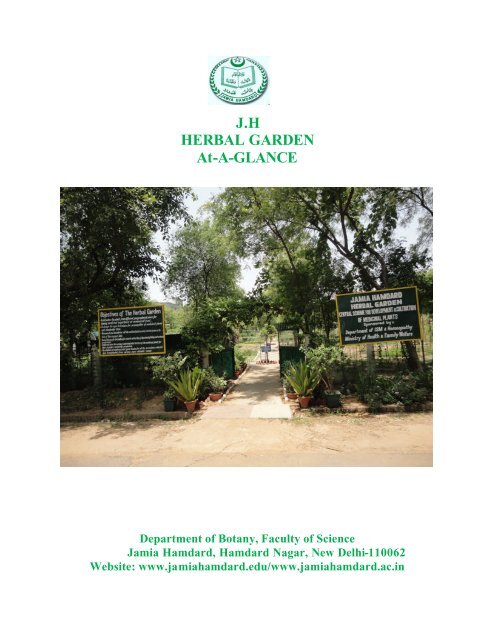

![BCA_2010[1] - Jamia Hamdard](https://img.yumpu.com/23632500/1/190x245/bca-20101-jamia-hamdard.jpg?quality=85)
